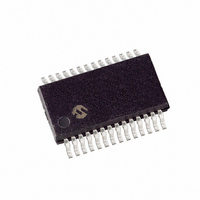PIC16F722-I/SS Microchip Technology, PIC16F722-I/SS Datasheet - Page 159

PIC16F722-I/SS
Manufacturer Part Number
PIC16F722-I/SS
Description
IC PIC MCU FLASH 2KX14 28-SSOP
Manufacturer
Microchip Technology
Series
PIC® XLP™ 16Fr
Datasheets
1.AC164112.pdf
(302 pages)
2.PIC16F722-ISS.pdf
(8 pages)
3.PIC16F722-ISS.pdf
(10 pages)
4.PIC16F722-ISS.pdf
(32 pages)
5.PIC16F722-ISS.pdf
(2 pages)
6.PIC16F722-ISS.pdf
(8 pages)
7.PIC16LF724-EP.pdf
(266 pages)
Specifications of PIC16F722-I/SS
Program Memory Type
FLASH
Program Memory Size
3.5KB (2K x 14)
Package / Case
28-SSOP
Core Processor
PIC
Core Size
8-Bit
Speed
20MHz
Connectivity
I²C, SPI, UART/USART
Peripherals
Brown-out Detect/Reset, POR, PWM, WDT
Number Of I /o
25
Ram Size
128 x 8
Voltage - Supply (vcc/vdd)
1.8 V ~ 5.5 V
Data Converters
A/D 11x8b
Oscillator Type
Internal
Operating Temperature
-40°C ~ 85°C
Processor Series
PIC16F
Core
PIC
Data Bus Width
8 bit
Data Ram Size
128 B
Interface Type
I2C/SCI/SPI
Maximum Clock Frequency
20 MHz
Number Of Programmable I/os
25
Number Of Timers
3
Maximum Operating Temperature
+ 85 C
Mounting Style
SMD/SMT
3rd Party Development Tools
52715-96, 52716-328, 52717-734
Development Tools By Supplier
PG164130, DV164035, DV244005, DV164005, PG164120
Minimum Operating Temperature
- 40 C
On-chip Adc
11-ch x 8-bit
Lead Free Status / RoHS Status
Lead free / RoHS Compliant
For Use With
AC164112 - VOLTAGE LIMITER MPLAB ICD2 VPPAC164307 - MODULE SKT FOR PM3 28SSOP
Eeprom Size
-
Lead Free Status / Rohs Status
Lead free / RoHS Compliant
Available stocks
Company
Part Number
Manufacturer
Quantity
Price
Company:
Part Number:
PIC16F722-I/SS
Manufacturer:
MICROCHI
Quantity:
60
Part Number:
PIC16F722-I/SS
Manufacturer:
MICROCHIP/微芯
Quantity:
20 000
16.3
Synchronous serial communications are typically used
in systems with a single master and one or more
slaves. The master device contains the necessary cir-
cuitry for baud rate generation and supplies the clock
for all devices in the system. Slave devices can take
advantage of the master clock by eliminating the
internal clock generation circuitry.
There are two signal lines in Synchronous mode: a
bidirectional data line and a clock line. Slaves use the
external clock supplied by the master to shift the serial
data into and out of their respective receive and trans-
mit shift registers. Since the data line is bidirectional,
synchronous operation is half-duplex only. Half-duplex
refers to the fact that master and slave devices can
receive and transmit data but not both simultaneously.
The AUSART can operate as either a master or slave
device.
Start and Stop bits are not used in synchronous
transmissions.
16.3.1
The following bits are used to configure the AUSART
for Synchronous Master operation:
• SYNC = 1
• CSRC = 1
• SREN = 0 (for transmit); SREN = 1 (for receive)
• CREN = 0 (for transmit); CREN = 1 (for receive)
• SPEN = 1
Setting the SYNC bit of the TXSTA register configures
the device for synchronous operation. Setting the CSRC
bit of the TXSTA register configures the device as a
master. Clearing the SREN and CREN bits of the RCSTA
register ensures that the device is in the Transmit mode,
otherwise the device will be configured to receive. Setting
the SPEN bit of the RCSTA register enables the
AUSART.
16.3.1.1
Synchronous data transfers use a separate clock line,
which is synchronous with the data. A device config-
ured as a master transmits the clock on the TX/CK line.
The TX/CK pin output driver is automatically enabled
when the AUSART is configured for synchronous
transmit or receive operation. Serial data bits change
on the leading edge to ensure they are valid at the trail-
ing edge of each clock. One clock cycle is generated
for each data bit. Only as many clock cycles are
generated as there are data bits.
© 2009 Microchip Technology Inc.
AUSART Synchronous Mode
SYNCHRONOUS MASTER MODE
Master Clock
PIC16F72X/PIC16LF72X
16.3.1.2
Data is transferred out of the device on the RX/DT pin.
The RX/DT and TX/CK pin output drivers are automat-
ically enabled when the AUSART is configured for
synchronous master transmit operation.
A transmission is initiated by writing a character to the
TXREG register. If the TSR still contains all or part of a
previous character, the new character data is held in
the TXREG until the last bit of the previous character
has been transmitted. If this is the first character, or the
previous character has been completely flushed from
the TSR, the data in the TXREG is immediately trans-
ferred to the TSR. The transmission of the character
commences immediately following the transfer of the
data to the TSR from the TXREG.
Each data bit changes on the leading edge of the
master clock and remains valid until the subsequent
leading clock edge.
16.3.1.3
1.
2.
3.
4.
5.
6.
7.
8.
Note:
Initialize the SPBRG register and the BRGH bit
to achieve the desired baud rate (refer to
Section 16.2 “AUSART Baud Rate Generator
(BRG)”).
Enable the synchronous master serial port by
setting bits SYNC, SPEN, and CSRC.
Disable Receive mode by clearing bits SREN
and CREN.
Enable Transmit mode by setting the TXEN bit.
If 9-bit transmission is desired, set the TX9 bit.
If interrupts are desired, set the TXIE bit of the
PIE1 register and the GIE and PEIE bits of the
INTCON register.
If 9-bit transmission is selected, the ninth bit
should be loaded in the TX9D bit.
Start transmission by loading data to the
TXREG register.
The TSR register is not mapped in data
memory, so it is not available to the user.
Synchronous Master Transmission
Synchronous Master Transmission
Set-up:
DS41341E-page 159

















